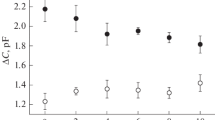Abstract
In the absence of added Fe2+, the ATPase activity of isolatedSchizosaccharomyces pombe plasma membranes (5–7 μmolP i per mg protein per min) is moderately inhibited by H2O2 in a concentration-dependent manner. Sizable inactivation occurs only at 50–80 mmol/L H2O2. The process, probably a direct oxidative action of H2O2 on the enzyme, is not induced by the indigenous membrane-bound iron (19.3 nmol/mg membrane protein), is not affected by the radical scavengers mannitol and Tris, and involves a decrease of both theK m of the enzyme for ATP and theV of ATP splitting. On exposing the membranes to the Fenton reagent (50 μmol/L Fe2+ +20 mmol/L H2O2), which causes a fast production of HO− radicals, the ATPase is 50–60% inactivated and 90% of added Fe2+ is oxidized to Fe3+ within 1 min. The inactivation occurs only when Fe2+ is added before H2O2 and can thus bind to the membranes. The lack of effect of radical scavengers (mannitol, Tris) indicates that HO− radicals produced in the bulk phase play no role in inactivation. Blockage of the inactivation by the iron chelator deferrioxamine implies that the process requires the presence of Fe2+ ions bound to binding sites on the enzyme molecules. Added catalase, which competes with Fe2+ for H2O2, slows down the inactivation but in some cases increases its total extent, probably due to the formation of the superoxide radical that gives rise to delayed HO− production.
Similar content being viewed by others
References
Barnett R.E., Palazotto J.: Mechanism of the effects of lipid phase transition on the Na+/K+-ATPase and the role of protein conformational changes.Ann. N.Y. Acad. Sci. 242, 9–76 (1975).
Block E.R.: Hydrogen peroxide alters the physical state and function of the plasma membrane of pulmonary artery endothelial cells.J. Cell Physiol. 146, 362–369 (1991).
Cogen U., Shinitzky M., Weber G., Nishida T.: Microviscosity and order in the hydrocarbon region of phospholipid and phospholipid—cholesterol dispersions determined with fluorescent probes.Biochemistry 12, 521–528 (1973).
Dufour J.-P., Amory A., Goffeau A.: Plasma membrane ATPase from the yeastSchizosaccharomyces pombe.Meth. Enzymol. 157, 513–527 (1988).
Fichera G., Sneider J., Wyman J.: On the existence of a steady state in a biological system.Proc. Nat. Acad. Sci. USA 74, 4180–4184 (1977).
Frew J., Jones P., Scholes G.: Spectroscopic determination of hydrogen peroxide and organic hydroperoxides at low concentrations in aqueous solutions.Anal. Chim. Acta 155, 139–150 (1983).
Gille G., Sigler K., Höfer M.: Response of catalase activity and membrane fluidity of aerobically grownSchizosaccharomyces pombe andSaccharomyces cerevisiae to aeration and the presence of substrates.J. Gen. Microbiol. 139, 1627–1634 (1993).
Gutz H., Heslot H., Leupold U., Loprieno N.:Schizosaccharomyces pombe, inHandbook of Genetics, Vol. 1 (R.C. King, Ed.), Plenum Press, London 1974.
Hallivell B., Gutteridge J.M.C.: Oxygen free radicals and iron in relation to biology and medicine: some problems and concepts.Arch. Biochem. Biophys. 246, 501–514 (1986).
Jähnig F.: Structural order of lipids and proteins in, proteins in membranes: evaluation of fluorescence anisotropy data.Proc. Nat. Acad. Sci. USA 76, 6361–6365 (1979).
Janda S., Beneš I., Opekarová M., Šťastná J., Tauchová R.: Effect of hydrogen peroxide on the aerobic yeastRhodotorula glutinis.Microbios Lett. 43, 37–42 (1990).
Janda S., Gille G., Sigler K., Höfer M.: Effect of hydrogen peroxide on sugar transport inSchizosaccharomyces pompe. Absence of membrane lipid peroxidation.Folia Microbiol. 38, 135–140 (1993).
Larson E., Howlett B., Jagendorf A.: Artificial reductant enhancement of the Lowry method for protein determination.Anal. Biochem. 155, 243–248 (1986).
Levine R.L.: Oxidative modification of glutamine synthetase. II. Characterization of the ascorbate model system.J. Biol. Chem. 258, 11828–11833 (1983).
Lippe G., Comelli M., Mazzilis D., Dabbeni Sala F., Mavelli I.: The inactivation of mitochondrial F1 ATPase by H2O2 is mediated by iron ions not tightly bound in the protein.Biochem. Biophys. Res. Commun. 181, 764–770 (1991).
Markwell M.A.K., Haas S.M., Bieberer L.L., Tolbert N.E.: A modification of the Lowry procedure to simplify protein determination in membrane and lipoprotein samples.Anal. Biochem. 87, 206–210 (1978).
Minotti G., Di Gennaro M., D'Ugo D., Granone P.: Possible sources of iron for lipid peroxidation.Free Radical Biol. Med. 12–13, 99–106 (1991).
Mishra O.P., Delivoria-Papadopoulos M., Cahillane G., Wagerle L.C.: Lipid peroxidation as the mechanism of modification of the affinity of the Na+, K+-ATPase active sites for ATP, K+, Na+, and strophantidinin vitro.Neurochem. Res. 14, 845–851 (1989).
Penner M.H., Yamasaki R.B., Osuga T.D., Babin D.R., Meares C.F., Feeney R.E.: Comparative oxidations of tyrosines and methionines in transferrins: human serum transferrin, human lactotransferrin, and chicken ovotransferrin.Arch. Biochem. Biophys. 225, 740–747 (1983).
Serrano R.: Structure and function of plasma membrane ATPase.Ann. Rev. Plant Physiol. Plant Mol. Biol. 40, 61–69 (1989).
Sigler K., Pokorná A., Opekarová M., Stadler N., Radovanović N., Höfer M.: Factors underlying the high sensitivity of membrane transports in the aerobic yeastRhodotorula glutinis to oxidative stress.XXVIth Annual Conf. Yeasts, p. 16, Smolenice 1997;Folia Microbiol. 42, 651 (1997).
Stadtman E.R.: Metal ion-catalyzed oxidation of proteins: biochemical mechanism, and biological consequences.Free Radical Biol. Med. 9, 315–325 (1990).
Stadtman E.R., Berlett A.P.: Fenton chemistry. Amino acid oxidations.J. Biol. Chem. 266, 17201–17211 (1991).
Szweda L.I., Stadtman E.R.: Iron-catalyzed oxidative modification of glucose-6-phosphate dehydrogenase fromLeuconostoc mesenteroides.J. Biol. Chem. 267, 3096–3100 (1992).
Toulon V., Sentenac H., Thibaud J.-B., Davidian J.-C., Moulineau C., Grignon C.: Role of apoplast acidification by the H+ pump. Effect on the sensitivity to pH and CO2 of iron reduction by roots ofBrassica napus L.Planta 186, 212–218 (1992).
van der Meer B.W., Van Hoeven R.P., Van Bletterswijk W.J.: Steady-state fluorescence polarization data in membranes. Resolution into physical parameters by an extended Perrin equation for restricted rotation of fluorophores.Biochim. Biophys. Acta 854, 38–44 (1986).
Author information
Authors and Affiliations
Rights and permissions
About this article
Cite this article
Sigler, K., Gille, G., Vacata, V. et al. Inactivation of the plasma membrane ATPase ofSchizosaccharomyces pombe by hydrogen peroxide and by the fenton reagent (Fe2+/H2O2): Nonradicalvs. Radical-induced oxidation. Folia Microbiol 43, 361–367 (1998). https://doi.org/10.1007/BF02818574
Received:
Issue Date:
DOI: https://doi.org/10.1007/BF02818574




